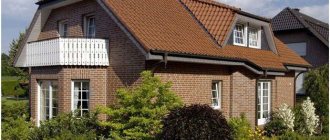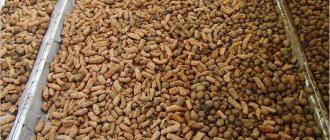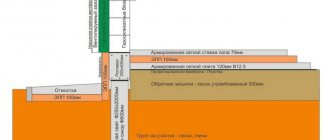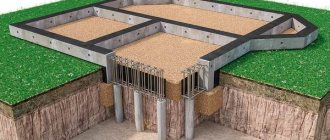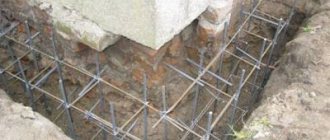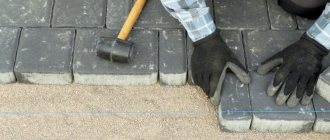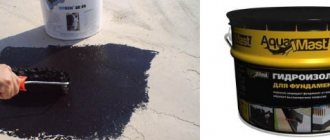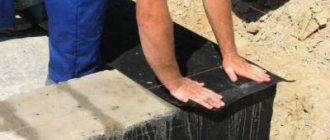The “enemy” of these structures is moisture. It is this that causes irreversible damage to any foundation.
Waterproofing the foundation with roofing felt is the most common way to create a barrier to the penetration of moisture into the house.
Description and features of the material
Waterproofing roofing felt is a building material, manufactured and supplied in rolls. The basis of the products is cardboard, which is impregnated with a low-melting fraction of bitumen on both sides.
Additionally, another layer of refractory bitumen is applied on the outside, followed by sprinkling with gravel or stone chips. The topping acts as a kind of reinforcement, giving additional strength to the material.
Scope of application
Rolled materials are used to construct moisture-proof coatings for foundations of various designs. Here are some examples:
Tape monolithic
Bituminous cardboard is laid in two layers
at the bottom of dug trenches with a sand-crushed stone cushion .
Moreover, the last strips are laid with the back side up or roofing felt is used. This is necessary so that the topping does not create micro air cavities, and the roofing material can fit tightly to the concrete.
After removing the formwork, all surfaces of the monolith are cleaned of irregularities and sagging, and cracks are minted with mortar. The horizontal surface of the tape is brought to a perfectly flat state.
The concrete is coated with hot mastic or a gas burner is used to melt the lower bitumen layer of roofing material. Then the roofing material is rolled onto the monolith with a special roller.
Belt prefabricated
All work on arranging waterproofing is similar to pasting a monolithic foundation. The difference is the absence of formwork.
A peculiarity of the foundations of buildings made of prefabricated reinforced concrete is that the horizontal surface of the tape requires additional cement screed for its final leveling.
The cement screed on the top of the strip foundation must be reinforced. The process involves grouting a semi-hardened mortar with dry cement. A durable layer with great adhesion is formed.
Basements
A sand-crushed stone cushion is installed on the open ground of the basement . Sheets of roofing felt are placed on top of the sand. Then a concrete screed with a thickness of at least 50 mm is installed. If the basement floor is below the groundwater level, then the screed is made 100 mm thick.
Base
Bituminous cardboard is laid on top of the plinth masonry. Together with waterproofing the bottom of the foundation, a double cordon is created that prevents moisture from penetrating into the structure of the walls and ceilings of the building.
Pile
A common practice for waterproofing piles is to double-wrap the upper (ground) part of the supports with roofing felt and pre-coat them with hot bitumen mastic. For small garden buildings, piles are formed in formwork from roofing felt rolled into pipes, which is a ready-made waterproofing for the base of the house.
Slab
The sand-crushed stone cushion in the formwork is covered with two layers of roofing felt without topping (roofing felt). After this, the formwork is poured with concrete.
The durability of the waterproofing produced can only be ensured by complete cleaning of dust, dirt, greasy formations and elimination of chips, cracks and other defects of the insulated foundation surfaces.
Vertical foundation protection
The installation of vertical plinth and foundation waterproofing is carried out in two ways. Before the advent of modern bituminous cold mastics and primers, strips of insulating roofing roll material were secured from the inside to the base structures with wooden beams and dowels. From the outside, the waterproofing of the basement and foundation parts was made from molten bitumen and resin. Few builders remember the time when homemade bitumen mastic was prepared in large containers at construction sites, and black smoke billowed over the construction site.
Performing vertical waterproofing
With the development of modern construction technologies, such an “ancient” method of installing waterproofing from timber, dowels and strips of rolled roofing material is simply not used. It is much simpler, faster, more convenient and, most importantly, safer, to make vertical waterproofing from roofing felt or other rolled insulating material fixed to bitumen mastic.
Vertical basement and foundation waterproofing can be carried out not only at the construction stage, but also during the operation of the house.
Sequence of vertical waterproofing with roofing felt
Reliable protection of the basement and foundation parts of the building from contact with water is provided by the installation of vertical wall protection. For this purpose, the surfaces, previously cleaned of dirt and residues of concrete or mortar, are primed with a bitumen primer, after which bitumen mastic is applied with a brush. Prepared pieces of roofing felt are glued with an overlap of 10 or 15 cm onto the foundation surface.
It is recommended to apply the adhesive insulation in two or three layers.
Video example of a basement waterproofing installation: Foundation waterproofing with roofing felt must be made in the form of a solid protective layer impenetrable to ground moisture. The joints of the rolled insulating material must be carefully glued so that there are no weak spots in the overall waterproofing carpet. If the requirements for waterproofing integrity are violated, significant costs for carrying out an impressive amount of work may turn out to be pointless and unnecessary tens of kilograms of insulating materials will simply be underground.
Pros and cons of use
A fairly simple method of waterproofing foundations has its advantages and disadvantages.
The popularity of the waterproofing method using roofing felt material is explained by the following:
- primitive laying technology does not require special professional training to perform the work;
- installation of a moisture-proof coating does not require special machinery and equipment;
- The method of laying protective material allows you to process from 15 to 30 m2 of the foundation surface during a working day.
The main disadvantage of roofing felt protection devices is the seasonality of work. Carrying out insulation work without forced heating in the winter season is fraught with loss of the quality characteristics of the coating. Certain inconveniences arise from handling a gas burner and heating the mastic over an open fire.
Preparation
The entire surface of the foundation must be completely cleaned of dirt, sand and soil. All cracks are sealed and leveled. For better adhesion, concrete should be coated with a special solution.
Leveling is necessary so that the roofing material is attached as tightly as possible to the surface. To fill cracks and level, a simple solution of cement and sand is used.
The foundation is covered in several layers with hot liquid bitumen or mastic. Thus, all cracks are sealed, and adhesion at the surface of the foundation is improved. Bitumen is applied using a brush or roller.
Cold mastic is a priority option, i.e.
because it is much easier to apply and has increased adhesiveness. You can add fluff to the mastic, this increases the waterproofing properties of the material.
If you want to save money, then bitumen bars are used, which must first be heated and only then applied to the surface. To improve the properties of bitumen, you can add used machine oil (no more than 20% of the volume of bitumen).
Which one is better to choose?
The building materials industry produces various types of bitumen cardboard. On the Russian building materials market you can mainly find 4 types of roll waterproofing:
- Euroroofing material has a synthetic base. It is used as a moisture-proof lining material under slate and other roofing products.
- Fiberglass ruberoid is a glass fabric impregnated with a bitumen composition and has high tensile strength. Most often used as a sandwich with intermediate filling with the main roofing material.
- Roofing felt is a traditional type of material without external topping. It is used as an additional intermediate layer of waterproofing of concrete structures, including foundations.
- Rubemast is a modern version of bitumen cardboard. It is a relatively cheap material that is very popular among developers for waterproofing foundation structures.
From the above it is clear that the best material for creating waterproofing for underground structures is Rubemast.
Useful tips
In conclusion, let's look at some useful tips:
- Work on laying the insulator should be carried out in clean work clothes (suit, gloves). The fact is that bitumen melts at a temperature of 180-200 degrees, so clothing will protect a person from possible burns due to installation errors. This recommendation is especially critical for beginners who have not yet done styling.
- It is also recommended to add safety glasses to the standard suit. They perform double duty. Firstly, they protect the eyes from debris and partial bitumen. Secondly, due to temperature convection, it will be difficult for you to look at the molten bitumen, and using glasses will avoid this problem.
It is recommended to carry out laying work in pairs, as this significantly simplifies the engineering task. One person will be responsible for marking and direct installation. While the second one will work with bitumen and heat the surface of the material for bonding. Theoretically, this task can be completed by one person, but he will have to work quickly (bitumen hardens quite quickly).
Stamps
To make the best choice in favor of a certain type of material, you need to understand its labeling. According to GOST requirements, all rolls of roofing felt are subject to mandatory marking.
It is printed on the paper cuff of the roll. If the brand is a combination of letters and numbers such as RPK-350, then this means the following:
- P – name of the material;
- P – lining material for insulating foundations;
- K – coarse-grained topping. There may be other letters. M – fine-grained, H – scaly, C – colored.
The numbers indicate the density of the material. In this example, it is 350 g/m2. This roofing material is suitable for both vertical and horizontal insulation of foundation surfaces.
Horizontal
Horizontal waterproofing involves gluing roofing felt to the foundation cushion using bitumen mastic.
This method protects the foundation and basement from moisture penetration from below. Insulation is carried out with a margin of 15-20 cm. After the construction of the foundation is completed, the remaining edges of the roofing material are folded up and attached to the concrete.
Horizontal waterproofing is mostly carried out during the construction of the foundation, with the goal of minimal compliance with building codes. Horizontal insulation cannot be called truly complete and worthy protection of the foundation from water.
How to use it correctly?
The installation of foundation waterproofing includes two stages of work:
- Preparatory stage.
- Installation stage.
Preparation
Preparatory work plays an important role in the quality of the waterproofing coating. The surfaces of the foundation should be as smooth as possible, without flaws.
Although bitumen mastics and the mastic back surface of the roll have high adhesion (they create strong adhesion to the surface being treated), it is worth considering the feasibility of treating concrete with penetrating impregnations.
Before pasting with roofing felt, experts recommend impregnating the foundation bases with primer compounds.
Laying
Roofing felt is laid in two ways:
The process of covering a foundation with waterproofing consists of gradually rolling out a roll and quickly pressing the roofing material against hot bitumen mastic previously applied to the surface of the foundation.- The second method saves workers from handling hot bitumen.
Use a material with a fusible base. It is gradually rolled out, heating the front surface of the roll with a gas burner. The whole process is accompanied by rolling the laid material with a roller.
Longitudinal connections of waterproofing strips are overlapped with a width of 100 - 150 mm. Transverse joining seams are also overlapped - 100 mm. This guarantees against damage to the integrity of the coating as a result of temperature deformations.
Waterproofing the floor with roofing felt
Roofing felt is used as an insulating material not only when laying foundations, but also when laying floors. Waterproofing is carried out in a situation where the room is characterized by high humidity, or to prevent moisture from entering between the floors when installing a screed.
Insulation is especially important if the floor is wood. Cement floors in rooms above basements also require additional protection.
The principle of using roofing felt for waterproofing a floor is the same as when insulating a foundation. The material is rolled out over the entire surface of the floor, so that it is slightly wrapped onto the walls. The strips are laid overlapping and glued with mastic. The edges of the roofing felt are attached to the walls using masking tape.
If the floor is reinforced concrete, after laying the roofing material, a screed is made. The laminate is immediately placed on the plank floor on top of the insulating layer through a special underlay. Attaching plywood to such a floor to level the surface will not work, as the waterproofing can be damaged.
What can be replaced?
If we consider only the roll type of waterproofing, then roofing felt can be replaced with materials such as fiberglass, fiberglass and polyester. New materials include more advanced versions of roofing felt of the following brands:
- Technique,
- Bipole,
- Bicroelast,
- Rubemast.
They are more expensive than regular bitumen cardboard, but have better characteristics.
Everything you need to know about foundation waterproofing can be found in this section.

